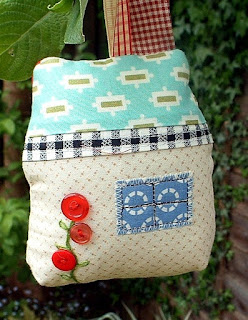Week 4 on the Zakka 2.0 trail is the Polka-Dot-Cafe Apron
- a project that is rated as a two star difficulty – a rating which in my humble opinion, has to be
taken with a large pinch-of-salt. The
rating may apply to the actual apron construction (not very difficult) but the
patchwork is a different matter. I love
patchwork but I needed to use my seam ripper and I lost the corners of my
little squares when sewing the pocket to the backing. But I am not a perfectionist so I won’t spend
another afternoon remaking the pocket – I won’t I tell you!
The term “Zakka” is a Japanese word that represents a
collection of items. This sew-along, together
with the first Zakka sew-along, both have a certain style – Japanese, linen,
simple lines, fussy-cut images – you know what I’m talking about. However, I am more modern country, gingham
and cotton prints. So I have constructed
my pocket in the typical style of this Patchsmith – complete with signature
bee!
Patchwork is an art and it takes practice. It is an activity that I enjoy. I am in the process of finishing off a table
runner which has a traditional block pattern which looks quite difficult but
isn’t – here is a quick glimpse.
 |
| I will stitch in the ditch rather than overstitch I tried overstitching and unpicked it as I didn't like the look. |
The apron pocket patchwork in the Polka-Dot-Cafe apron looks
tricky and it is. You may end up with three blocks that look perfect. However, when you have finished and you come to join the
three blocks together you will need a lot of patience especially
if you want to get all seams to match and not to lose any points. You may create three perfect blocks stitched
together, as I thought I had, only to find you lose some points when you stitch
it to the background. The points are there – you just can’t see them.
But never fear - here are some Patchsmith points to replace those you've lost:
p.s. I shall be
buying some twill in the week and will finish my apron ready to post to the
Flickr group at the end of the week but in the meantime pop over to
Cut-to-Pieces, the blog host for this week and take a peek at her beautiful,
all-points-present apron. But never fear - here are some Patchsmith points to replace those you've lost:
1. If you
don’t have a ¼” foot then you can draw a ¼” seam allowance on the WRONG side of
your fabrics - or add a piece of tape to the needleplate of your machine to help you keep on the straight and narrow.
2. When
matching points just stitch where the points meet initially and not the whole seam. Once you are happy that you still have your
points (if not your sanity) then go ahead and stitch the rest of the seam.
3. Patch the four large triangles once all other pieces have been
stitched together. Centre the point of
the triangle with the centre of the large square to make sure it is in the
right place. Regard the diagram on page 53 of the book as three diagonal units that you stitch together before adding the large triangle corner points.
4. Do not
worry if your finished block is not 6½” – you can adjust the pocket lining
measurements to suit. Just make sure you trim all blocks to the same size.
5. If you
are new to patchwork (or you wish to remain sane) don’t go for fussy cut motifs
for the little squares but pick a multi-directional pattern.
6. Check out Sewzalot’s version – she has added a strip between the blocks – cutting the need to match the points block-to-block. I wish I’d thought of this!!!
6. Check out Sewzalot’s version – she has added a strip between the blocks – cutting the need to match the points block-to-block. I wish I’d thought of this!!!
And the point of this whole project - indeed the point of this sew-along? The point is to enjoy the process and ditch the
perfectionism. Smile and congratulate
yourself, enjoy your efforts and give yourself an “A star” for completing this
functional project. But whatever you do –
don’t rate your efforts in relation to the two star difficulty rating as you
may be left missing the point!
Sew until later .................








































